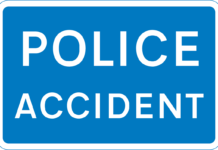The recent case of R v Holden and Houghton heralds a new and disturbing approach to Police Pursuits by the CPS. Mark Aldred, the barrister who defended both officers, considers the implications arising out of this case. In particular he considers the very real risk of prosecutions being brought based on the police driver being held responsible for the danger created by the actions of the subject driver.
PC’s Holden and Houghton were both attached to the Roads Policing Unit and were both trained to the highest levels in pursuit driving. The pursuit that they were involved in lasted about 4 minutes. At this point the subject driver went through a level crossing barrier and made off. PC Holden stood the pursuit down. No one was injured. Neither the subject vehicle nor the police vehicle collided with any third party. There was no public complaint. PC Holden was chasing a serial burglar. An independent review of the drive by another force expert described PC Holden’s drive as “admirable” and “not careless, reckless or dangerous” and “typical of an urban pursuit”. However, the in-force review panel felt, in retrospect, the risk was too great and the pursuit ought to have been terminated some 1minute 30 seconds earlier.
PC Houghton was the radio operator in PC Holden’s vehicle and the Pursuit Commander. Both officers were prosecuted for Dangerous Driving. A central plank of the case against each of them was that they both had a responsibility to discontinue when the risks became disproportionate and they had not done so. The prosecution case against PC Holden was largely based upon the danger created by the subject driver. In the words of the prosecutor,
“If you continue to pursue you continue to expose the public to risk of serious injury and serious damage to property. That is dangerous”
By failing to terminate at the point where the force head of driving standards had (retrospectively) decided that the risk had become disproportionate, PC Holden had in effect “caused” the subject vehicle to drive in a dangerous manner and was responsible for the danger that resulted. In the words of the prosecutor;
“He [the subject driver] is a dangerous driver. He will exhibit risk. The contention is PC Holden continued when it was disproportionate and exposed other road users to risk”
The case against PC Houghton was dismissed at committal. However, PC Holden’s case survived the committal and a half time submission. One is tempted to ask the question, why was this not dealt with by the in force procedures? However the more pertinent questions are, “how did get this case get past the CPS, a District Judge and a Crown Court Judge? Why did it go all the way to a jury? If it does go to a jury what protections or exemptions do police have? Are police drivers who engage in pursuits at risk of a similar fate to that of PC Holden in the event someone refers a drive which is “typical of an urban pursuit” to the CPS? The fact that PC Holden’s case survived all the legal hurdles suggests that the view of the CPS cannot be said to be an aberration. The real problem is the law and the lack of protection it offers police pursuit drivers.
This first concern is that it seems there is now a willingness to hold an officer legally responsible for the danger created by the driver he is pursuing. If a subject vehicle makes off he will create a danger. He will exceed the speed limit. He will ignore road signs. The ACPO guidelines tell us that “all pursuits are inherently dangerous”. Does this mean all officers who pursue could be liable for causing or perpetuating that danger? An answer along the lines of “only if the officer pursues when he should have discontinued” is no answer at all. There will always be a difference of professional opinion about when and if a pursuit becomes disproportionate. At either end of the spectrum, the answer will be obvious. In the middle it is a finely balanced judgment. There will be differences. In PC Holden’s case neither he, nor the Pursuit Commander, nor the RPU driver in car 2 of the pursuit, nor the Control room Supervisor nor the Controller felt the need to terminate before it was terminated. An independent Driving Expert, chosen by the prosecution, also did not feel the pursuit ought to have been terminated before it was. However, on the basis of the opinion of the head of driver training, supported by a Traffic Sergeant, the prosecution was mounted. Once it had started, it continued under its own momentum, through committal, through a half time submission, all the way to a jury.
Once the case is before the jury the officer is really exposed. If the danger relied on by the prosecution is that created by the fleeing driver, then, on the argument in PC Holden’s case, the police driver will have caused or contributed to the danger by continuing to pursue. This argument may well be supplemented by an argument that the officer, in driving at speed in an urban environment, exposed the public to danger and was therefore dangerous. This also occurred in PC Holden’s case.
These arguments can be applied to virtually any substantive pursuit. In any pursuit of a criminal intent on escaping, the criminal will expose the public to risk. That is why ACPO tells us “all pursuits are inherently dangerous”. Officers conducting pursuits will, by pursuing, cause the subject to make off. They will exceed the speed limit and they will contravene road signs. The problem is, if these arguments are mounted by the prosecution to support a charge of Dangerous Driving, they are very difficult to counter.
The yardstick against which an officer’s driving will be judged is not the standard of a trained police pursuit driver. It is the standard of the careful and competent driver. Did the officer’s driving fall far below the standard of the careful and competent driver? Unfortunately, the careful and competent driver does not engage in pursuits, nor does he contravene traffic signs and speed limits. Yes a police officer has exemptions under road traffic legislation but there is no exemption from dangerous driving.
The prosecution may well ask the officer whether he thought the driving of the subject vehicle was dangerous. The answer will obviously be “yes”. The radio commentary may well describe the offender’s driving as dangerous. However, the police officer will be following the subject vehicle, in that same urban area, at speed. If there are no legal exemptions permitting dangerous driving by a police officer during a pursuit, what distinguishes a police pursuit driver from the subject he is pursuing? The obvious answer is his training and his skill. Unfortunately, since the case of R v Bannister, a jury is not permitted to take into account an officer’s special skill and training in determining whether the driving was dangerous because the yardstick against which the driving is measured is the standard of the careful and competent driver, not one with special skills. Neither is the special skill of an officer a “circumstance” which a jury is entitled to take into consideration when considering if an all the circumstances, the driving was dangerous.
Legally speaking, the question for the jury could be,
“Did the driving of the officer, in continuing to pursue, at speed, in an urban area, fall far below the standard of the careful and competent driver in such a way as to cause a risk of serious injury or damage, bearing in mind the officer has no exemptions in law to drive dangerously and that his skill and training are not to be taken into consideration in deciding whether there was such a risk.”
One only has to put it that way to realise how exposed a police driver is.
At present, forces have the best of both worlds, they can tell the public there is not a no pursuit policy but, when it is politically expedient, officers who pursue can be prosecuted and, if they are, the law offers them little in the way of protection.
Thankfully for PC Holden, the jury applied a common sense approach and acquitted him. However, that was after a year of worry that he would lose his job and possibly his liberty. Until the law is changed a police officer can only hope that a reviewer does not refer his case for prosecution. The other option is for the driver not to pursue at all. However if he does pursue, and his case is referred, a police officer is left in a very exposed position, reliant upon a good barrister and a jury that accepts common sense arguments. The Police Federation can control the former, but not the latter.
Mark Aldred, Barrister












